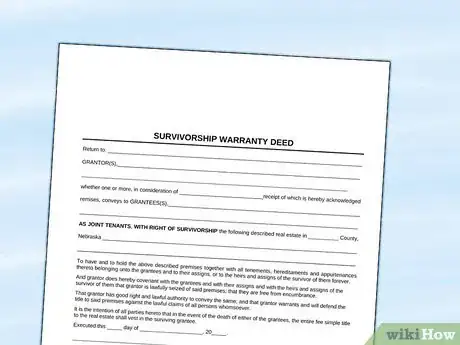This article was written by Jennifer Mueller, JD. Jennifer Mueller is an in-house legal expert at wikiHow. Jennifer reviews, fact-checks, and evaluates wikiHow's legal content to ensure thoroughness and accuracy. She received her JD from Indiana University Maurer School of Law in 2006.
There are 8 references cited in this article, which can be found at the bottom of the page.
wikiHow marks an article as reader-approved once it receives enough positive feedback. In this case, 91% of readers who voted found the article helpful, earning it our reader-approved status.
This article has been viewed 211,978 times.
If you own your own home, you may decide that you want to add someone, such as a new spouse or an adult child, to your house title. Unlike some other types of property, you can't just add their name to the existing deed. To add someone to your house title, you must create a new deed that transfers the title of the property to both you and the other person.[1]
Steps
Evaluating Financial and Legal Consequences
-
1Determine whether you'll lose any property tax exemptions. Depending on the age of the person you plan to add to your house title, other property they own, or other factors, you may lose a property tax exemption you currently have.
- For example, if you have a property tax exemption because you are over 65, you would lose that exemption if you added your daughter to your house title.
- Property tax exemptions mean that you pay lower property taxes, and sometimes no property tax at all. These exemptions vary among states. Some common exemptions include homestead exemptions or exemptions for people over the age of 65.
- If you look at your property tax statement, it should indicate whether you're receiving any property tax exemptions. You can also find out by contacting the tax assessor's office in your county.
-
2Calculate potential gift taxes. When you add someone to your house title, you're effectively giving them a share of the property. Depending on the value of your property, you may be on the hook for federal gift taxes at the end of the year. Consult a tax professional if you believe the gift tax may apply.
- The gift tax applies if you transfer ownership of property and receive nothing in return (or receive less than market value for the ownership interest you transferred). It doesn't matter whether you intended it to be a gift or not.[2]
- The transfer is excluded from the gift tax if you're adding your spouse to your house title.[3]
Advertisement -
3Find out if the property is subject to reassessment. When you transfer ownership of your house, it triggers a reassessment of the value of the property for tax purposes in most cases. You could end up paying hundreds of dollars more in property taxes as a result.[4]
- Some transfers are excluded from reassessment. The types of transfers that are excluded vary among states.
- For example, if you are adding a spouse to your house title, the deed transfer will be exempt from reassessment in many states.
-
4Contact your lender if you're paying a mortgage. Many mortgages contain a clause that requires you to pay the mortgage in full if you transfer the title of your house. This includes adding someone else to your house title. To avoid enforcement of this clause, ask your lender's permission.[5]
- These clauses typically state that if you ask your lender for permission to add someone to your house title, they won't unreasonably refuse. However, in practice, they may refuse regardless of who you're adding to your house title or why.
- If your lender agrees not to enforce the clause, get the agreement in writing. Especially with large lenders, it isn't uncommon to get a bill for the balance of the mortgage when the transfer is complete.
-
5Consult an attorney regarding estate issues. Adding someone to your house title can have legal and financial consequences if either of you dies. Particularly if your house is worth a considerable amount of money or is your only major asset, you may want advice from an experienced estate planning attorney.[6]
- How you add the person to your title affects whether the surviving owner must go through probate. If avoiding probate is a priority, an attorney can help you find the best method to add the other person to your house title.
Choosing the Form of Co-Ownership
-
1Evaluate your control and survivorship preferences. Differentiate the forms of co-ownership by deciding what you want to happen to the property when an owner dies, or if one owner wants to sell the property while both of you are alive.[7]
- If you want the property to automatically pass to the other owner with the death of one owner, choose a form of co-ownership that includes the "right to survivorship."
- Choose separate interests if you want one owner to be able to sell their interest in the property without consulting the other owner. You can't have it both ways, however. Owners with separate interests won't have a right to survivorship of the other owner's interest.
-
2Use a tenancy in common if you want separate ownership interests. With a tenancy in common, both owners have separate ownership interests in the property, but the property is undivided and both owners have the right to possess the whole property.[8]
- The separate interest refers to the monetary interest in the property. For example, you may set it up so that you have an 80 percent interest in the property while your sister has a 20 percent interest in the property. This means if the property was sold, you would get 80 percent of the money from the sale and your sister would get the remaining 20 percent.
- Co-owners who are tenants in common can use the property as security on a loan or take out a mortgage on the property, but only to the extent of their ownership interest. For example, if you owned an 80 percent interest and your sister a 20 percent interest, your sister could only take out a mortgage for 20 percent of the value of the property.
- To create a tenancy in common, you would use "and" or "or" between the names of the property owners on the deed. For example, "Suzy Sunshine and Martin Moon" or "Suzy Sunshine or Martin Moon."
-
3Create a joint tenancy if you want undivided, joint ownership. Unlike a tenancy in common, with a joint tenancy, both of you own the entire property, not a separate interest. A joint tenancy has a right to survivorship, which means if one owner dies the surviving owner automatically gets the entire property.[9]
- You must use specific language in your deed to create a joint tenancy. For example, it would work to say "Suzy Sunshine and Martin Moon as joint tenants with right of survivorship and not as tenants in common."
- Your state law may have other specific languages to use. Check with a property law attorney if you want to create a joint tenancy and are unsure of the language to use.
-
4Set up a tenancy by the entirety if you're married. A tenancy by the entirety is similar to joint tenancy with right of survivorship, in that each spouse owns the entire property. When one spouse dies, the other spouse owns the property.[10]
- The difference between tenancy by the entirety and joint tenancy with right of survivorship is that if one spouse has debts, that spouse's creditors can't go after the other spouse's interest in the property to cover those debts.
- With a tenancy by the entirety, one spouse cannot take out a mortgage on the property or do anything else to encumber the property without the consent of the other spouse.
- Tenancy by the entirety is only available for married couples and is not recognized in some states. Talk to a property law attorney if you're interested in creating a tenancy by the entirety.
Executing and Recording the Deed
-
1Get a copy of your current deed. Your current deed typically is located at the recorder's office for the county where your house is located. To find the right office, search online for "recorder" or "register of deeds" with the name of your county.[11]
- Your county recorder may charge a small fee to pull the deed, and typically will charge an additional fee to make a copy of it for you. These fees usually won't be more than $20.
- There are companies that will offer to provide you a copy of your deed, but you're better off dealing with the recorder's office directly. These companies will charge significantly more money than you would pay if you got a copy directly from the recorder's office.[12]
-
2Choose the type of deed form you want to use. The two most common types of deeds are quitclaim deeds and grant deeds (also called warranty deeds in some states). The type you choose has legal and financial consequences.[13]
- When you use a quitclaim deed, you're only transferring any ownership interest you have. You're not guaranteeing you have any interest at all, or that you have particular ownership or possession rights.
- With a grant deed, you are making a promise that you are the current owner of the property and that there aren't any liens, mortgages, or other claims to the property that you haven't disclosed.
-
3Do a title search if you are using a grant deed. A grant deed includes a promise that you own your home free and clear. To make that guarantee, examine public records on the history of your house's ownership through a title search.[14]
- You should also purchase title insurance in case there is a lien or other claim on the land that the title search didn't bring up. You can buy one of these policies by paying a one-time fee, which typically is relatively low.
- You can do your title search yourself, or you can order one from the title company that issues your title insurance policy. Unless you know real estate and property records fairly well, it's usually safer to let the title company do it.
-
4Fill out your new deed. Type the information for your new deed, or write neatly using blue or black ink. Copy information about the property exactly as it appears on your current deed, including the parcel number or description of the property.[15]
- Include your name and the name of the person you want to add to your house title. Use full legal names, and the appropriate language to create the type of co-ownership you've chosen.
- Especially if you previously consulted an attorney, you may want to have them look over the new deed and make sure it will achieve your goals for co-ownership of your house.
-
5Sign your new deed in the presence of a notary. As the "grantor" of the property, you must sign the deed and have your signature notarized. The person you're adding to your house title (the "grantee") does not have to sign the deed.[16]
- The notary will charge a small fee to witness your signature and notarize your deed, typically less than $10.
- Bring a government-issued photo ID with you when you get your signature notarized. The notary will need to verify your identity.
-
6Take the new deed to the county recorder's office. Once you've signed the deed, take it to the recorder's office where you got the copy of your old deed. You may have to fill out a form to have the deed officially recorded, as well as pay a small fee.[17]
- You may also have to pay a document transfer tax. For example, Sacramento County charges a one-time tax of 1.1% of the value of the property when you file a new deed. There are exceptions, such as if the other person is not paying you any money to be added to the deed.
-
7File a claim with the tax assessor if necessary. Any time property changes hands, the tax assessor's office will reassess the value of that property for tax purposes. This typically increases your property taxes. However, some types of transfers are excluded from reassessment.[18]
- If you are adding a spouse or a child to your house title, the transfer typically will be excluded from reassessment.
References
- ↑ https://www.consumer-action.org/english/articles/before_you_add_someone_to_your_title2006/
- ↑ https://www.irs.gov/businesses/small-businesses-self-employed/gift-tax
- ↑ https://www.irs.gov/businesses/small-businesses-self-employed/frequently-asked-questions-on-gift-taxes
- ↑ https://saclaw.org/wp-content/uploads/sbs-completing-and-recording-deeds.pdf
- ↑ https://www.americanbar.org/content/dam/aba/publishing/rpte_ereport/2015/2-March/enforceability_of_mortgage.authcheckdam.pdf
- ↑ https://saclaw.org/wp-content/uploads/sbs-completing-and-recording-deeds.pdf
- ↑ https://www.extension.iastate.edu/agdm/wholefarm/html/c4-51.html
- ↑ https://www.extension.iastate.edu/agdm/wholefarm/html/c4-51.html
- ↑ https://www.extension.iastate.edu/agdm/wholefarm/html/c4-51.html
- ↑ https://www.extension.iastate.edu/agdm/wholefarm/html/c4-51.html
- ↑ https://saclaw.org/wp-content/uploads/sbs-completing-and-recording-deeds.pdf
- ↑ http://cookrecorder.com/deed-providers/
- ↑ https://saclaw.org/wp-content/uploads/sbs-completing-and-recording-deeds.pdf
- ↑ http://realestate.findlaw.com/buying-a-home/do-you-need-title-insurance.html
- ↑ https://saclaw.org/wp-content/uploads/sbs-completing-and-recording-deeds.pdf
- ↑ https://saclaw.org/wp-content/uploads/sbs-completing-and-recording-deeds.pdf
- ↑ https://saclaw.org/wp-content/uploads/sbs-completing-and-recording-deeds.pdf
- ↑ https://saclaw.org/wp-content/uploads/sbs-completing-and-recording-deeds.pdf
About This Article
Before you add someone to your house title, consider consulting an attorney to better understand the legal and financial repercussions of doing so. Keep in mind that you may lose property tax exemptions or be charged gift taxes for adding someone to your title. Transferring ownership of a house also means your property will likely be reassessed for tax purposes. If you’re paying a mortgage, get your lender’s written permission to transfer your house title, and if your house is a major asset, consult an estate attorney regarding potential estate issues. Once you’re sure you want to move forward, decide on what kind of co-ownership you want based on your situation. Get a copy of your current deed and select the type of new deed form you want to use. Finally, neatly fill out your new deed, sign in the presence of a notary, and file the new deed at the county recorder’s office. For more detailed information on how to add someone to your house title, scroll down.














































































